International Journal of Intelligent Systems and Applications @ijisa
Статьи журнала - International Journal of Intelligent Systems and Applications
Все статьи: 1214
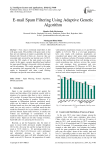
E-mail Spam Filtering Using Adaptive Genetic Algorithm
Статья научная
Now a day’s everybody email inbox is full with spam mails. The problem with spam mails is that they are not malicious in nature so generally don’t get blocked with firewall or filters etc., however, they are unwanted mails received by any internet users. In 2012, more that 50% emails of the total emails were spam emails. In this paper, a genetic algorithm based method for spam email filtering is discussed with its advantages and dis-advantages. The results presented in the paper are promising and suggested that GA can be a good option in conjunction with other e-mail filtering techniques can provide more robust solution.
Бесплатно
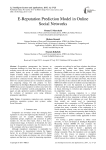
E-reputation prediction model in online social networks
Статья научная
E-reputation management has become an important challenge for firms that try to improve their notoriety across the web and more specifically in social media. Indeed, the power of online communities to impact a brand’s image is undeniable and companies need a powerful system to measure their reputation as perceived by connected society. Moreover, they need to follow its variation and forecast its evolution to anticipate any impacting change. For this purpose we have implemented an Intelligent Reputation Measuring System (IRMS) that assesses reputation in online social networks on the basis of members’ activity and popularity. In this paper, we add a predictive module to IRMS that forecasts the evolution of reputation score using influence propagation algorithms.
Бесплатно
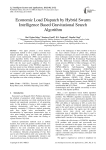
Economic Load Dispatch by Hybrid Swarm Intelligence Based Gravitational Search Algorithm
Статья научная
This paper presents a novel heuristic optimization method to solve complex economic load dispatch problem using a hybrid method based on particle swarm optimization (PSO) and gravitational search algorithm (GSA). This algorithm named as hybrid PSOGSA combines the social thinking feature in PSO with the local search capability of GSA. To analyze the performance of the PSOGSA algorithm it has been tested on four different standard test cases of different dimensions and complexity levels arising due to practical operating constraints. The obtained results are compared with recently reported methods. The comparison confirms the robustness and efficiency of the algorithm over other existing techniques.
Бесплатно
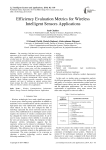
Efficiency Evaluation Metrics for Wireless Intelligent Sensors Applications
Статья научная
The metrology field has been progressed with the appearance of the wireless intelligent sensor systems providing more capabilities such as signal processing, remote multi-sensing fusion etc. This kind of devices is rapidly making their way into medical and industrial monitoring, collision avoidance, traffic control, automotive and others applications. However, numerous design challenges for wireless intelligent sensors systems are imposed to overcome the physical limitations in data traffic, such as system noise, real time communication, signal attenuation, response dynamics, power consumption, and effective conversion rates etc, especially for applications requiring specific performances. This paper analyzes the performance metrics of the mentioned sensing devices systems which stands for superior measurement, more accuracy and reliability. Study findings prescribe researchers, developers/ engineers and users to realizing an optimal sensing motes design strategy that offers operational advantages which can offer cost-effective solutions for an application.
Бесплатно

Efficient Data Clustering Algorithms: Improvements over Kmeans
Статья научная
This paper presents a new approach to overcome one of the most known disadvantages of the well-known Kmeans clustering algorithm. The problems of classical Kmeans are such as the problem of random initialization of prototypes and the requirement of predefined number of clusters in the dataset. Randomly initialized prototypes can often yield results to converge to local rather than global optimum. A better result of Kmeans may be obtained by running it many times to get satisfactory results. The proposed algorithms are based on a new novel definition of densities of data points which is based on the k-nearest neighbor method. By this definition we detect noise and outliers which affect Kmeans strongly, and obtained good initial prototypes from one run with automatic determination of K number of clusters. This algorithm is referred to as Efficient Initialization of Kmeans (EI-Kmeans). Still Kmeans algorithm used to cluster data with convex shapes, similar sizes, and densities. Thus we develop a new clustering algorithm called Efficient Data Clustering Algorithm (EDCA) that uses our new definition of densities of data points. The results show that the proposed algorithms improve the data clustering by Kmeans. EDCA is able to detect clusters with different non-convex shapes, different sizes and densities.
Бесплатно

Efficient and Fast Initialization Algorithm for K-means Clustering
Статья научная
The famous K-means clustering algorithm is sensitive to the selection of the initial centroids and may converge to a local minimum of the criterion function value. A new algorithm for initialization of the K-means clustering algorithm is presented. The proposed initial starting centroids procedure allows the K-means algorithm to converge to a “better” local minimum. Our algorithm shows that refined initial starting centroids indeed lead to improved solutions. A framework for implementing and testing various clustering algorithms is presented and used for developing and evaluating the algorithm.
Бесплатно

Статья научная
Classification is found to be an important field of research for many applications such as medical diagnosis, credit risk and fraud analysis, customer segregation, and business modeling. The main intention of classification is to predict the class labels for the unlabeled test samples using a labelled training set accurately. Several classification algorithms exist to classify the test samples based on the trained samples. However, they are not suitable for many real world applications since even a small performance degradation of classification algorithms may lead to substantial loss and crucial implications. In this paper, a simple classification method using the average weighted pattern score with attribute rank based feature selection has been proposed. Feature selection is carried out by computing the attribute score based ranking and the classification is performed using average weighted pattern computation. Experiments have been performed with 40 standard datasets and the results are compared with other classifiers. The outcome of the analysis shows the good performance of the proposed method with higher classification accuracy.
Бесплатно

Efficient clustering algorithm with enhanced cohesive quality clusters
Статья научная
Analyzing data is a challenging task nowadays because the size of data affects results of the analysis. This is because every application can generate data of massive amount. Clustering techniques are key techniques to analyze the massive amount of data. It is a simple way to group similar type data in clusters. The key examples of clustering algorithms are k-means, k-medoids, c-means, hierarchical and DBSCAN. The k-means and DBSCAN are the scalable algorithms but again it needs to be improved because massive data hampers the performance with respect to cluster quality and efficiency of these algorithms. For these algorithms, user intervention is needed to provide appropriate parameters as an input. For these reasons, this paper presents modified and efficient clustering algorithm. This enhances cluster’s quality and makes clusters more cohesive using domain knowledge, spectral analysis, and split-merge-refine techniques. Also, this algorithm takes care to minimizing empty clusters. So far no algorithm has integrated these all requirements that proposed algorithm does just as a single algorithm. It also automatically predicts the value of k and initial centroids to have minimum user intervention with the algorithm. The performance of this algorithm is compared with standard clustering algorithms on various small to large data sets. The comparison is with respect to a number of records and dimensions of data sets using clustering accuracy, running time, and various clusters validly measures. From the obtained results, it is proved that performance of proposed algorithm is increased with respect to efficiency and quality than the existing algorithms.
Бесплатно

Efficient intelligent framework for selection of initial cluster centers
Статья научная
At present majority of research is on cluster analysis which is based on information retrieval from data that portrays the objects and their association among them. When there is a talk on good cluster formation, then selection of an optimal cluster core or center is the necessary criteria. This is because an inefficient center may result in unpredicted outcomes. Hence, a sincere attempt had been made to offer few suggestions for discovering the near optimal cluster centers. We have looked at few versatile approaches of data clustering like K-Means, TLBOC, FEKM, FECA and MCKM which differs in their initial center selection procedure. They have been implemented on diverse data sets and their inter and intra cluster formation efficiency were tested using different validity indices. The clustering accuracy was also conducted using Rand index criteria. All the algorithms computational complexity was analyzed and finally their computation time was also recorded. As expected, mostly FECA and to some extend FEKM and MCKM confers better clustering results as compared to K-Means and TLBOC as the former ones manages to obtain near optimal cluster centers. More specifically, the accuracy percentage of FECA is higher than the other techniques however, it’s computational complexity and running time is moderately higher.
Бесплатно

Effort estimation of back-end part of software using chaotically modified genetic algorithm
Статья научная
The focus of Software Development Effort Estimation (SDEE) is to precisely predict the estimation of effort and time required for successfully developing a software project. From the past few years, data-intensive applications with a huge back-end part are contributing to the overall effort of projects. Therefore, it is becoming more important to add the back-end part to the SDEE process. This paper proposes an Evolutionary Learning (EL) based hybrid artificial neuron termed as dilation-erosion perceptron (DEP) framework from the mathematical morphology (MM) having its foundation in complete lattice theory (CLT) for solving the SDEE problem. In this work, we used the DEP (CMGA) model utilizing a chaotically modified genetic algorithm (CMGA) for the construction of DEP parameters. The proposed method uses the ER diagram artifacts such as aggregation, specialization, generalization, semantic integrity constraints, etc. for calculating the SDEE of back-end part of the business software. Furthermore, the proposed method was tested over two different datasets, one is existing and the other one is a self-developed dataset. The performance of the given method is then evaluated by three popular performance metrics, exhibiting better performance of the DEP (CMGA) model for solving the SDEE problems.
Бесплатно

Статья научная
This paper proposes a new, simple and user–friendly MATLAB built-in function, mathematical and Simulink models, to be used to early identify system level problems, to ensure that all design requirements are met, and, generally, to simplify Mechatronics motion control design process including; performance analysis and verification of a given electric DC machine, proper controller selection and verification for desired output speed or angle.
Бесплатно

Emotion Detection of Tweets in Indonesian Language using Non-Negative Matrix Factorization
Статья научная
Emotion detection is an application that is widely used in social media for industrial environment, health, and security problems. Twitter is ashort text messageknown as tweet. Based on content and purposes, the tweet can describes as information about a user’s emotion. Emotion detection by means oftweet, is a challenging problem because only a few features can be extracted. Getting features related to emotion is important at the first phase of extraction, so the appropriate features such as a hashtag, emoji, emoticon, and adjective terms are needed. We propose a new method for analyzing the linkages among features and reducedsemantically using Non-Negative Matrix Factorization (NMF). The dataset is taken from a Twitter application using Indonesian language with normalization of informal terms in advance. There are 764 tweets in corpus which have five emotions, i.e. happy (senang), angry (marah), fear (takut), sad (sedih), and surprise(terkejut). Then, the percentage of user’s emotion is computed by k-Nearest Neighbor(kNN) approach. Our proposed model achieves the problem of emotion detectionwhich is proved by the result near ground truth.
Бесплатно

Empirical Study of Impact of Various Concept Drifts in Data Stream Mining Methods
Статья научная
In the real world, most of the applications are inherently dynamic in nature i.e. their underlying data distribution changes with time. As a result, the concept drifts occur very frequently in the data stream. Concept drifts in data stream increase the challenges in learning as well, it also significantly decreases the accuracy of the classifier. However, recently many algorithms have been proposed that exclusively designed for data stream mining while considering drifting concept in the data stream.This paper presents an empirical evaluation of these algorithms on datasets having four possible types of concept drifts namely; sudden, gradual, incremental, and recurring drifts.
Бесплатно

Empirical Support for Concept Drifting Approaches: Results Based on New Performance Metrics
Статья научная
Various types of online learning algorithms have been developed so far to handle concept drift in data streams. We perform more detailed evaluation of these algorithms through new performance metrics - prequential accuracy, kappa statistic, CPU evaluation time, model cost, and memory usage. Experimental evaluation using various artificial and real-world datasets prove that the various concept drifting algorithms provide highly accurate results in classifying new data instances even in a resource constrained environment, irrespective of size of dataset, type of drift or presence of noise in the dataset. We also present empirically the impact of various features- size of ensemble, period value, threshold value, multiplicative factor and the presence of noise on all the key performance metrics.
Бесплатно

Employing Fuzzy-Histogram Equalization to Combat Illumination Invariance in Face Recognition Systems
Статья научная
With the recent surge in acceptance of face recognition systems, more and more work is needed to perfect the existing grey areas. A major concern is the issue of illumination intensities in the images used as probe and images trained in the database. This paper presents the adoption and use of fuzzy histogram equalization in combating illumination variations in face recognition systems. The face recognition algorithm used is Principal Component Analysis, PCA. Histogram equalization was enhanced using some fuzzy rules in order to get an efficient light normalization. The algorithms were implemented and tested exhaustively with and without the application of fuzzy histogram equalization to test our approach. A good and considerable result was achieved.
Бесплатно

Energy Aware Ad Hoc On-Demand Multipath Distance Vector Routing
Статья научная
The current disjoint path Ad hoc On-Demand Multi-path Distance Vector (AOMDV) routing protocol does not have any energy-awareness guarantees. When AOMDV is used in wireless sensor networks (WSNs) energy is an important consideration. To enhance the AOMDV protocol an extra energy metric is added along with the hop count metric. This Energy aware or EA-AOMDV improves path selection using a trade-off between energy and hop count, thus giving more longevity to WSNs. EA-AOMDV is compared to the current AOMDV routing protocol to prove its worth in the context of WSNs. It is found that EA-AOMDV leads to better WSN energy-awareness in resource constrained WSNs.
Бесплатно

Energy Efficient Fitness Based Routing Protocol for Underwater Sensor Network
Статья научная
Underwater sensor network is one of the potential research arenas that opens the window of pleasing a lot of researcher in studying the field. Network layer of the underwater sensor networks must be one of the most attractive fields to build up anew protocol. In this paper, we proposed a underwater sensor network routing protocol named Energy Efficient Fitness based routing protocol for under water sensor networks (EEF) that promises the best use of total energy consumptions. The proposed routing protocol takes into account residual energy, depth and distance from the forwarding node to the sink node to guide a packet from source to the destination node. The prominent advantages of the proposed protocol are to confirm higher network life time and less end to end delay. The proposed protocol does not use control packet that causes much energy consumption and end to end delay. Simulation has been performed to certify the better result of the proposed routing protocol.
Бесплатно

Energy Optimized Ad hoc on-Demand Multipath Routing Protocol for Mobile Ad hoc Networks
Статья научная
As the wireless nodes are having limited battery life, energy efficiency is the most important design consideration in mobile ad hoc networks. Many multipath routing schemes are possibly exploiting multiple disjoint routes between any pair of source and destination in order to provide aggregated bandwidth, fault-tolerance and load-balancing properties. Hence we propose an optimized energy efficient routing scheme by slightly modifying MMRE-AOMDV route update rules in order to generate more energy efficient routes than MMRE-AOMDV routing protocol, called an Optimized Minimal Maximal nodal Residual Energy AOMDV (OMMRE-AOMDV) protocol. It reduces the energy consumption, average end to end delay, routing overhead and normalized routing overhead. It also improves packet delivery ratio and throughput. Simulation results show that the OMMRE-AOMDV routing protocol has performed better than AOMDV and MMRE-AOMDV routing protocols.
Бесплатно

Energy Resource Management of Assembly Line Balancing Problem using Modified Current Search Method
Статья научная
This paper aims to apply a modified current search method, adaptive current search (ACS), for assembly line balancing problems. The ACS algorithm possesses the memory list (ML) to escape from local entrapment and the adaptive radius (AR) mechanism to speed up the search process. The ACS is tested against five benchmark unconstrained and three constrained optimization problems compared with genetic algorithm (GA), tabu search (TS) and current search (CS). As results, the ACS outperforms other algorithms and provides superior results. The ACS is used to address the number of tasks assigned for each workstation, while the heuristic sequencing (HS) technique is conducted to assign the sequence of tasks for each workstation according to precedence constraints. The workload variance and the idle time are performed as the multiple-objective functions. The proposed approach is tested against four benchmark ALB problems compared with the GA, TS and CS. As results, the ACS associated with the HS technique is capable of producing solutions superior to other techniques. In addition, the ACS is an alternative potential algorithm to solve other optimization problems.
Бесплатно
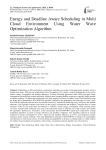
Статья научная
Scheduling is an NP-hard problem, and heuristic algorithms are unable to find approximate solutions within a feasible time frame. Efficient task scheduling in Cloud Computing (CC) remains a critical challenge due to the need to balance energy consumption and deadline adherence. Existing scheduling approaches often suffer from high energy consumption and inefficient resource utilization, failing to meet stringent deadline constraints, especially under dynamic workload variations. To address these limitations, this study proposes an Energy-Deadline Aware Task Scheduling using the Water Wave Optimization (EDATSWWO) algorithm. Inspired by the propagation and interaction of water waves, EDATSWWO optimally allocates tasks to available resources by dynamically balancing energy efficiency and deadline adherence. The algorithm evaluates tasks based on their energy requirements and deadlines, assigning them to virtual machines (VMs) in the multi-cloud environment to minimize overall energy consumption while ensuring timely execution. Google Cloud workloads were used as the benchmark dataset to simulate real-world scenarios and validate the algorithm's performance. Simulation results demonstrate that EDATSWWO significantly outperforms existing scheduling algorithms in terms of energy efficiency and deadline compliance. The algorithm achieved an average reduction of energy consumption by 21.4%, improved task deadline adherence by 18.6%, and optimized resource utilization under varying workloads. This study highlights the potential of EDATSWWO to enhance the sustainability and efficiency of multi-cloud systems. Its robust design and adaptability to dynamic workloads make it a viable solution for modern cloud computing environments, where energy consumption and task deadlines are critical factors.
Бесплатно

